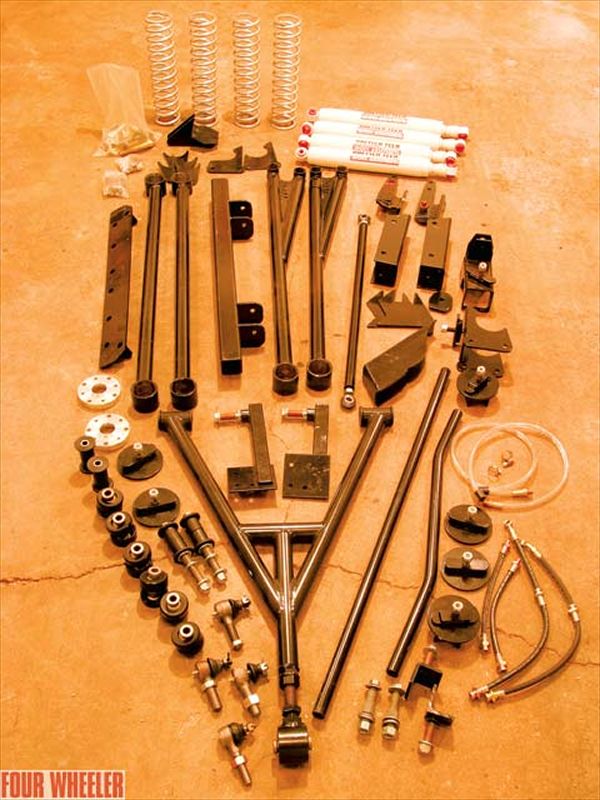
 Ken Brubaker
Senior Editor, Four Wheeler
Ken Brubaker
Senior Editor, Four Wheeler
Celebrated former Four Wheeler Feature Editor Ben Stewart used to say: "Real Jeeps have round springs." He coined this phrase shortly after the Wrangler TJ was introduced, when everyone else was fixated on the shape of the TJ's headlights. Historically, what he said wasn't true, but we all knew what he meant. When Jeep gave the plucky little Wrangler coil springs, it set a new precedent for out-of-the-box flex, ride, and handling. There was no doubt that it smoked its leaf-sprung predecessors. In short, it performed.
So here we are, eight years later, wondering if coil springs could work the same magic for our little leaf-sprung Suzuki Samurai . There was one way to find out; we contacted the folks at Rocky Road Outfitters and got our hands on their trick front and rear coil-suspension kit for the Suzuki Samurai. For those of you not familiar with Rocky Road, they've been in the 4x4 biz since 1997. Owner Glenn Wakefield actually started making Suzuki Samurai parts in 1988 after he bought a Suzuki Samurai and found that there weren't many aftermarket suspension parts available. (Some of you may remember Wakefield and his built-from-scratch Suzuki Samurai, dubbed "Zukini," from the 1997 Top Truck Challenge.) Nowadays, Rocky Road offers a variety of parts for Suzukis as well as Jeeps of all lineages. In the near future they'll add a full collection of Toyota parts to their resume. The Rocky Road folks are also active in the 'wheeling world, engaging in trail maintenance in their home state of Utah.

Rocky Road Outfitters says that this 8-inch-lift coil kit will accept up to 33-inch-diameter tires and 35- or 36-inch tires with a body lift. They also offer a 6-inch coil kit designed to fit 31- or 32-inch-diameter tires. This kit has a relatively high install difficulty rating. You'll need a fair amount of cutting and welding experience, and it helps to have a thorough understanding of suspension tech and geometry. Part of this is due to differences in specs from Suzuki Samurai to Suzuki Samurai, which force changes to be made in the placement of some components.
The photos and captions will give you a basic idea of what we installed, and how it does what it does. Many of these images were taken when the suspension was mocked up for testing and before final welding and painting took place.

1. The lower coil mounts weld to the front axle (passenger side shown). They provide a mounting location for the lower coil springs, shock absorbers and the control arms as well as the track bar on the passenger side. Nothing has to be removed from the axle for them to be installed. They rest above the existing spring pad and self-align for pinion angle.

2. Here you can see the passenger-side front control arm being mounted to the coil mount. Like the rear control arms, the new Y-arm front control arms are 35 inches in length and they're manufactured from 3/16-inch-wall DOM tubing. Interestingly, Rocky Road points out that they are twice the thickness of the stock Samurai frame. The bottom of the front shocks mount to longer bolts integrated into the control arm/coil mount.

3. The front of the rear control arms and the rear of the front control arms mount to framerail mounts that weld to the frame. Here you can see a mount tack-welded in place after we mocked up the suspension system.

4. This is the new center crossmember that serves as the mounting point for the front of the rear Y-link. It is made of 2x2 square tubing and comes with four welded-on Y-link mounting brackets. The new crossmember is welded to a pair of gussets that are in turn welded to the outside of the frame.

5. Here is the mini truss and center Y-link mounts welded to the rear axle. This component provides a center mounting point for the rear of the Y-link. We took the liberty of beefing the Y-link mounts with some gusseting.

6. On the right you can see the front driver-side 8-inch-lift coil spring mounted to the stock bumpstop using the new upper coil mount. The mounts weld to the bumpstops after removing the stock rubber piece. On the left you can see the new front track-bar mount and track bar. Like many of the other weld-on components, the track-bar mount is not welded in permanently until the axle is in place so its fore and aft mounting can be fine-tuned so it doesn't interfere with the steering links or the coil spring. Also notable is that the track bar is held on each end by a caliper mounting system so that the arm is held securely on two planes.

7. The optional upper front shock-mount kit requires you to remove the factory upper front shock mounts. With them out of the way and the frame ground flat, the new mounts simply bolt on. The kit includes sleeves for the mounting bolts so that when the bolts are tightened, the frame is not crushed. Also noteworthy is that the Doetsch Tech shock absorbers feature built-in bumpstops.

8. Here you can see the new passenger-side steering arm that's included with the Over The Top steering system. It mounts using six bolts. The knuckle arms are cut from machine-grade steel with horizontal grain and they come with a lifetime warranty.

9. This is how the passenger-side track bar/lower coil spring/shock mount/control arm assembly looked after we mocked it up and tack-welded it for testing. Once we were convinced that all of the mounting locations were correct we welded it permanently.

10. We had to relocate the brake proportioning valve slightly rearward in the vehicle because it could be contacted by the lower rear passenger-side link during full suspension travel. Here you can see our crappy temporary homemade bracket that we made so we could get the vehicle on the trail for testing. We also had to cut off, rebend, and reflare the rear brake lines. The kit came with new 5-inch front brake-line extensions.

11. On the left you can see the new rear axle vent tube. The old one was in the way of the Y-link mount, so a new one had to be drilled and tapped. You'll notice that the end of the Y-link is adjustable so you can fine-tune the pinion angle. It also features a large Johnny joint. Rocky Road says that the Y-link eliminates spring wrap or other torque twisting.
Results
The first thing we noticed after installing the Rocky Road Outfitters 8-inch front and rear coil suspension kit and Over the Top steering system was the total lack of creepy steering. This says a lot. Bumpsteer is eliminated, the entire steering system is mounted high to avoid trail damage, and no funky tweaking even when fully flexed was most welcome. And talk about flex; our little Samurai is a flexy beast. Rocky Road says that depending on wheel and tire choice, you can expect close to 40 inches of articulation, and we believe it. We're still debugging our just-completed Samurai, but we're very impressed by the overall articulation we've seen so far, and we expect it to improve further as the suspension components break in. The ride is also vastly improved, even with the heavier front springs we ordered to compensate for an upcoming V-6 swap. Bottom line: We got the results we expected, and our little Samurai is now a serious playa off-highway. It looks pretty cool too.



